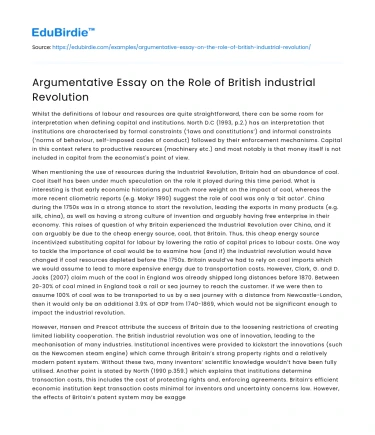Whilst the definitions of labour and resources are quite straightforward, there can be some room for interpretation when defining capital and institutions. North D.C (1993, p.2.) has an interpretation that institutions are characterised by formal constraints (‘laws and constitutions’) and informal constraints (‘norms of behaviour, self-imposed codes of conduct) followed by their enforcement mechanisms. Capital in this context refers to productive resources (machinery etc.) and most notably is that money itself is not included in capital from the economist's point of view.
When mentioning the use of resources during the Industrial Revolution, Britain had an abundance of coal. Coal itself has been under much speculation on the role it played during this time period. What is interesting is that early economic historians put much more weight on the impact of coal, whereas the more recent cliometric reports (e.g. Mokyr 1990) suggest the role of coal was only a ‘bit actor’. China during the 1750s was in a strong stance to start the revolution, leading the exports in many products (e.g. silk, china), as well as having a strong culture of invention and arguably having free enterprise in their economy. This raises of question of why Britain experienced the Industrial Revolution over China, and it can arguably be due to the cheap energy source, coal, that Britain. Thus, this cheap energy source incentivized substituting capital for labour by lowering the ratio of capital prices to labour costs. One way to tackle the importance of coal would be to examine how (and if) the industrial revolution would have changed if coal resources depleted before the 1750s. Britain would’ve had to rely on coal imports which we would assume to lead to more expensive energy due to transportation costs. However, Clark, G. and D. Jacks (2007) claim much of the coal in England was already shipped long distances before 1870. Between 20-30% of coal mined in England took a rail or sea journey to reach the customer. If we were then to assume 100% of coal was to be transported to us by a sea journey with a distance from Newcastle-London, then it would only be an additional 3.9% of GDP from 1740-1869, which would not be significant enough to impact the industrial revolution.
Save your time!
We can take care of your essay
- Proper editing and formatting
- Free revision, title page, and bibliography
- Flexible prices and money-back guarantee
However, Hansen and Prescot attribute the success of Britain due to the loosening restrictions of creating limited liability cooperation. The British industrial revolution was one of innovation, leading to the mechanisation of many industries. Institutional incentives were provided to kickstart the innovations (such as the Newcomen steam engine) which came through Britain’s strong property rights and a relatively modern patent system. Without these two, many inventors’ scientific knowledge wouldn’t have been fully utilised. Another point is stated by North (1990 p.359.) which explains that institutions determine transaction costs, this includes the cost of protecting rights and, enforcing agreements. Britain’s efficient economic institution kept transaction costs minimal for inventors and uncertainty concerns low. However, the effects of Britain’s patent system may be exaggerated. MacLeod (1988) found that a large proportion of invention research was carried out outside of the patent system. This idea suggests that the patent system wasn’t as influential in the industrial revolution as presumed.
What was notable was Britain’s wage structure at the time, relative to other countries, Britain had high wages. This gave businesses an incentive to invent technology to substitute labour for capital and energy. Allen (2011) states how the supply of the technology, which in turn leads to capital, was augmented by the high wage rate. The labour force was therefore in a better position to undertake education and training. In turn, this led to higher literacy rates which contributed to the inventions and innovations.
Labour is another factor which has no doubt contributed towards the British industrial revolution. Stevens (1995) expressed that England had a relative abundance of ‘technical literacy’ which means that there was a relative high proportion of people in the labour force with strong mechanical knowledge and material properties.
In conclusion, I believe it’s clear that a combination of good institutional framework, cheap resources, a skilled and educated labour force and capital ownership have all led to Britain’s success during the industrial revolution. The interconnection of these factors suggests that Britain wouldn’t have revolutionised without one of them. Upon reviewing the literature, we can suggest that Britain’s coal abundance was not as beneficial as assumed as imports of coal to Britain wouldn’t have changed the course of the revolution much. With the lowering transport costs, coal would’ve still been cheap enough to be regarded as a good energy source in Britain. Mokyr puts his emphasis on institutions providing good incentives, along with the scientific knowledge and skilled craftsmen Britain had. The Royal Society 1660 is an example of a scientific institution that was underpinned during the industrial revolution.






 Stuck on your essay?
Stuck on your essay?

